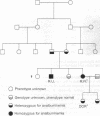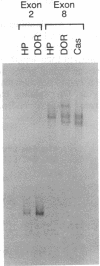Abstract
In analbuminemia, a very rare inherited syndrome, subjects produce little or no albumin (1/100th to 1/1000th normal), presumably because of a mutation in the albumin gene; yet, they have only moderate edema and few related symptoms owing to a compensatory increase in other plasma proteins. Because of the virtual absence of albumin the defect must be identified at the DNA level. In this study the mutation causing analbuminemia in an Italian family was investigated by analysis of DNA from a mother and her daughter. The mother was homozygous for the trait and had a serum albumin value of < 0.01 g/dl (about 1/500th normal); the daughter was heterozygous for the trait and had a nearly normal albumin value. Molecular cloning and sequence analysis of DNA from both mother and daughter showed that the mutation is caused by a nucleotide insertion in exon 8; this produces a frameshift leading to a premature stop, seven codons downstream. The methods of heteroduplex hybridization and single-strand conformation polymorphism were used to compare the DNA of the mother and daughter to the DNA of two unrelated analbuminemic individuals (one Italian and one American). This showed that all three analbuminemic individuals had different mutations; these also differed from the mutation in the only human case previously studied at the DNA level, which was a splicing defect affecting the ligation of the exon 6-exon 7 sequences. Thus, analbuminemia may result from a variety of mutations and is genetically heterogeneous.
Full text
PDF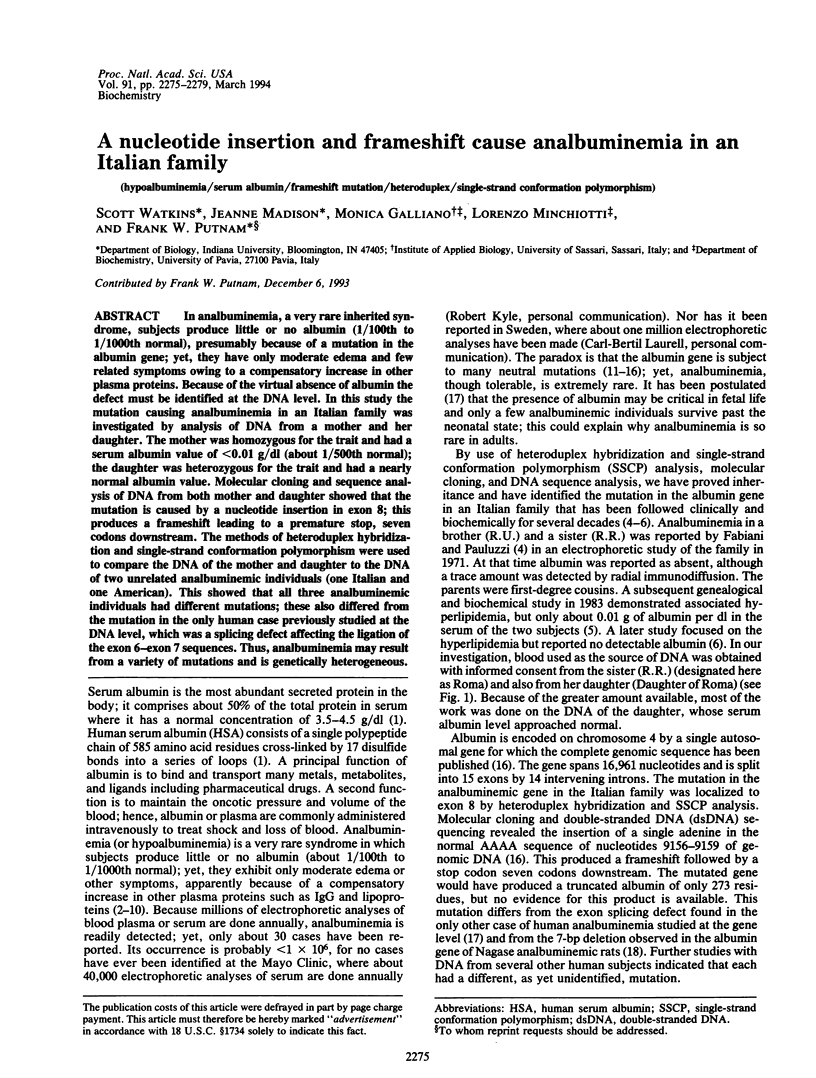
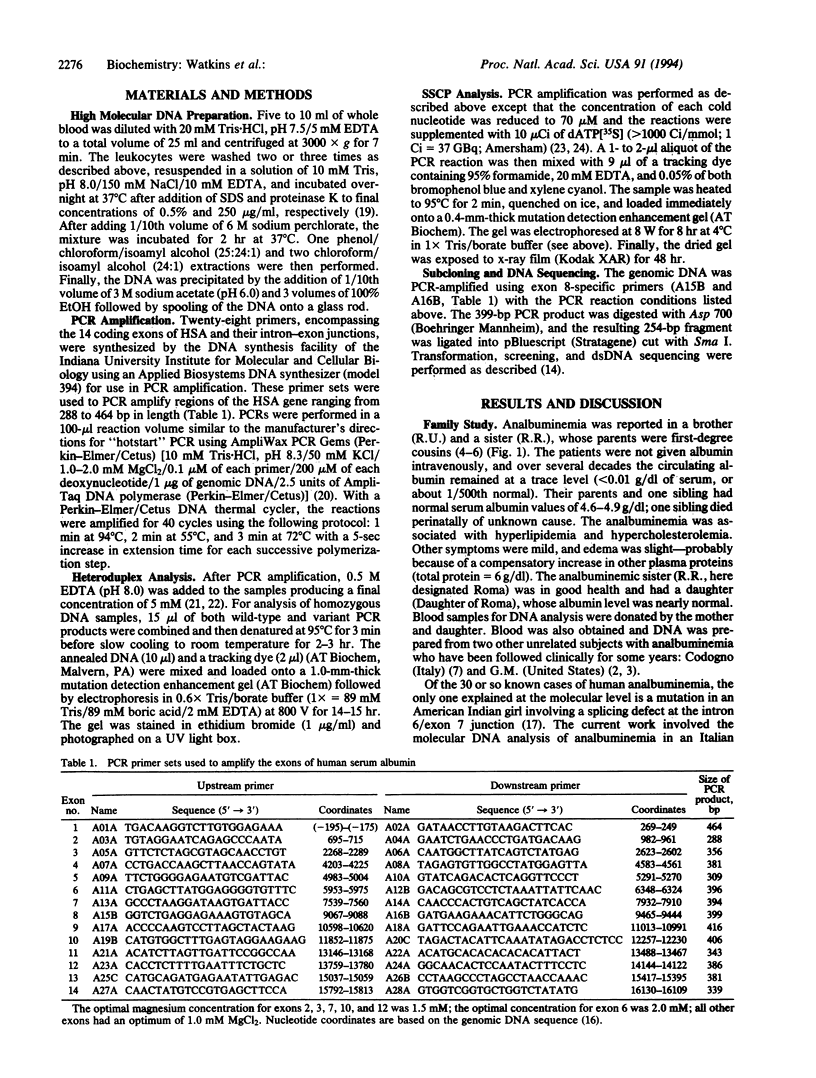
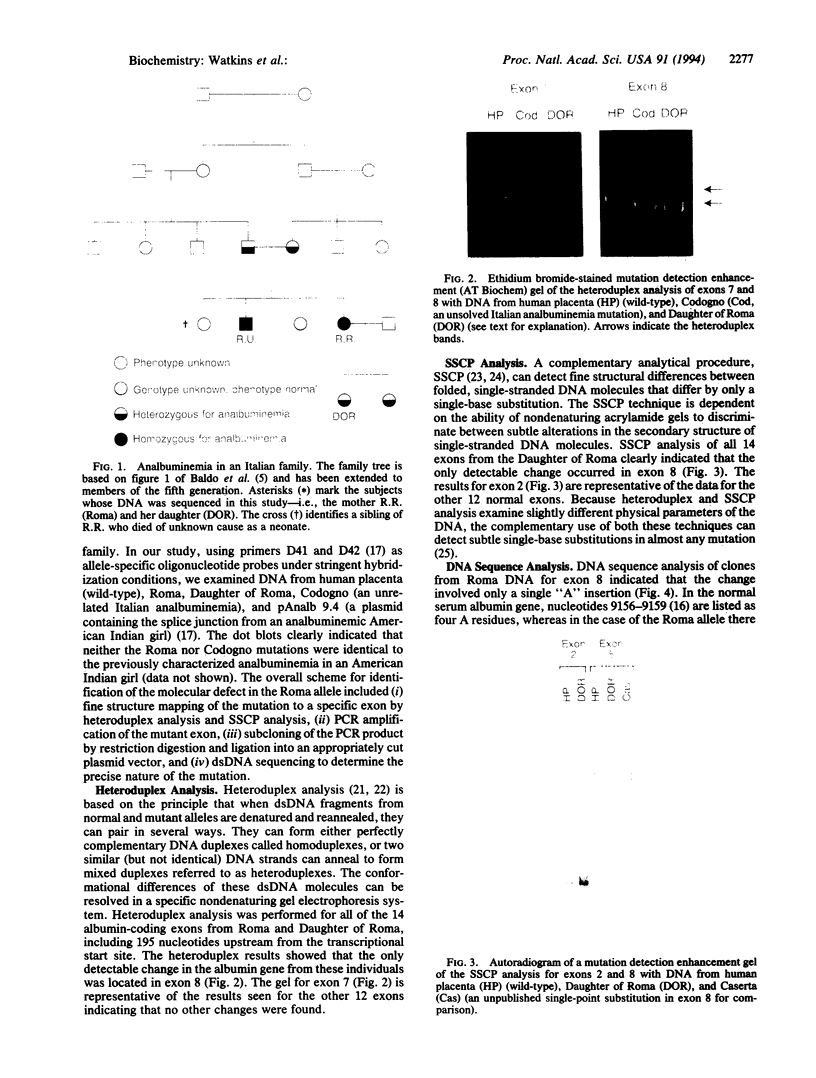
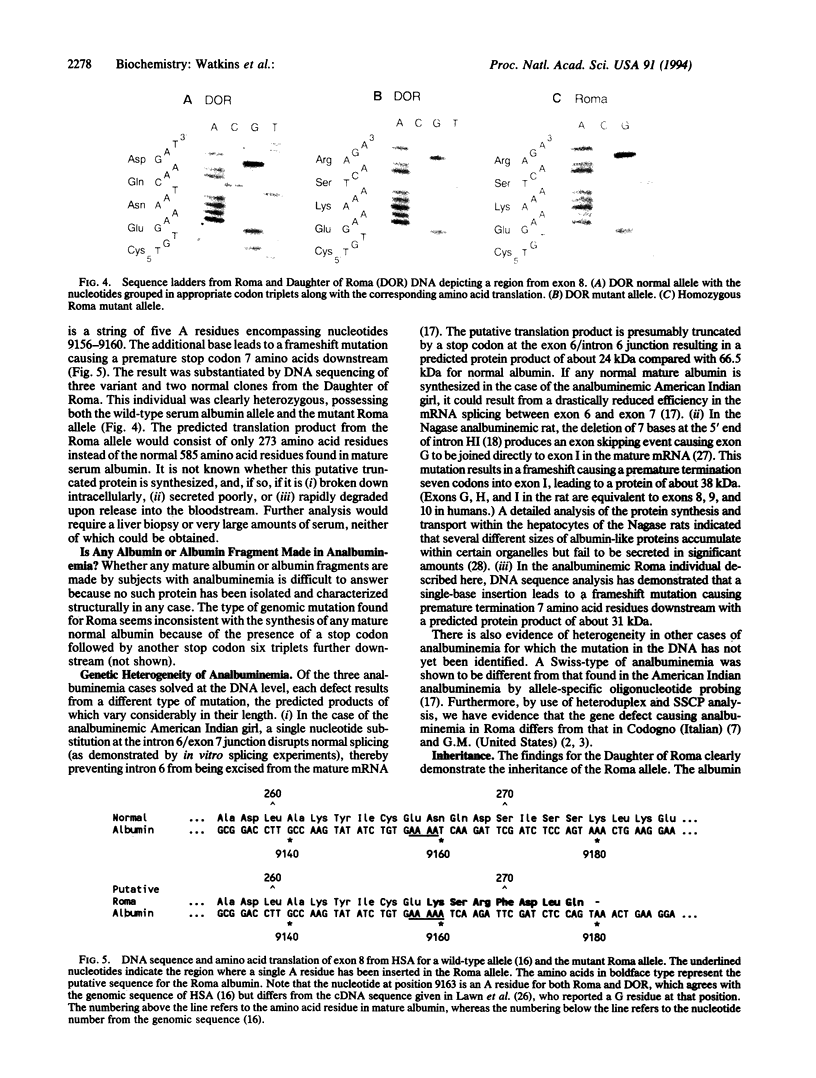
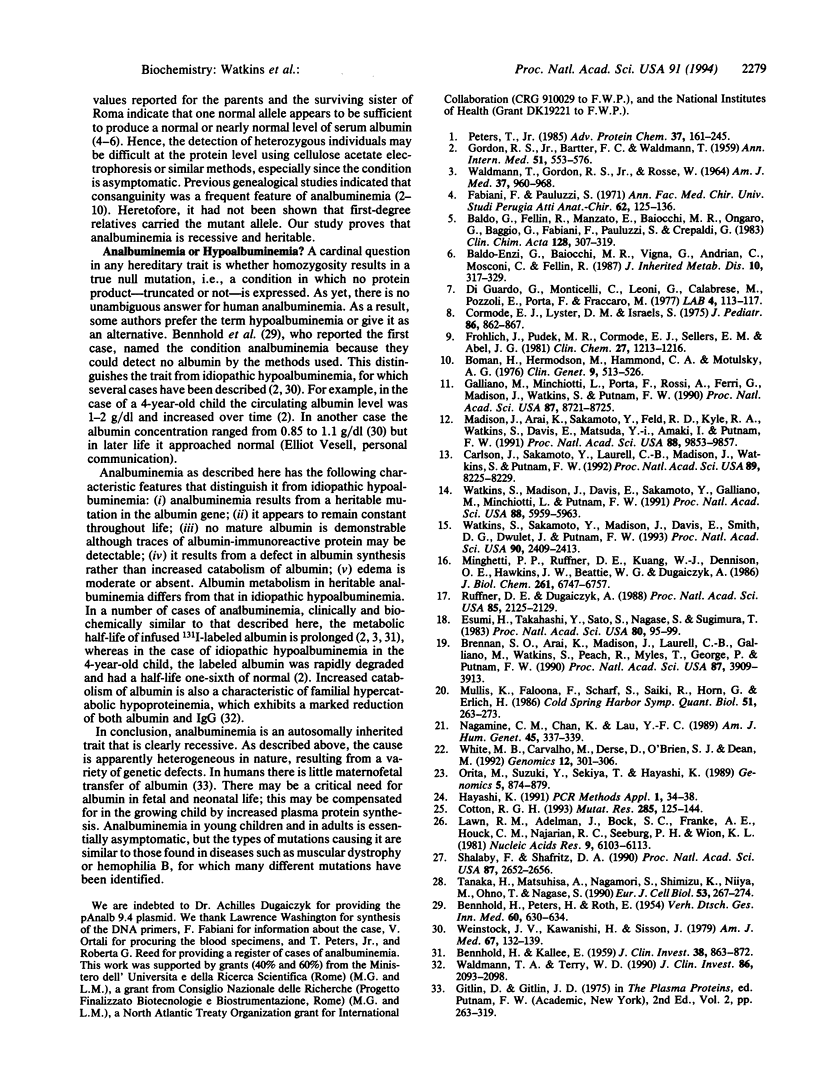
Images in this article
Selected References
These references are in PubMed. This may not be the complete list of references from this article.
- BENNHOLD H., KALLEE E. Comparative studies on the half-life of I 131-labeled albumins and nonradioactive human serum albumin in a case of analbuminemia. J Clin Invest. 1959 May;38(5):863–872. doi: 10.1172/JCI103868. [DOI] [PMC free article] [PubMed] [Google Scholar]
- Baldo-Enzi G., Baiocchi M. R., Vigna G., Andrian C., Mosconi C., Fellin R. Analbuminaemia: a natural model of metabolic compensatory systems. J Inherit Metab Dis. 1987;10(4):317–329. doi: 10.1007/BF01799973. [DOI] [PubMed] [Google Scholar]
- Baldo G., Fellin R., Manzato E., Baiocchi M. R., Ongaro G., Baggio G., Fabiani F., Pauluzzi S., Crepaldi G. Characterization of hyperlipidemia in two patients with analbuminemia. Clin Chim Acta. 1983 Mar 14;128(2-3):307–319. doi: 10.1016/0009-8981(83)90330-3. [DOI] [PubMed] [Google Scholar]
- Boman H., Hermodson M., Hammond C. A., Motulsky A. G. Analbuminemia in an American Indian girl. Clin Genet. 1976 May;9(5):513–526. doi: 10.1111/j.1399-0004.1976.tb01606.x. [DOI] [PubMed] [Google Scholar]
- Brennan S. O., Arai K., Madison J., Laurell C. B., Galliano M., Watkins S., Peach R., Myles T., George P., Putnam F. W. Hypermutability of CpG dinucleotides in the propeptide-encoding sequence of the human albumin gene. Proc Natl Acad Sci U S A. 1990 May;87(10):3909–3913. doi: 10.1073/pnas.87.10.3909. [DOI] [PMC free article] [PubMed] [Google Scholar]
- Carlson J., Sakamoto Y., Laurell C. B., Madison J., Watkins S., Putnam F. W. Alloalbuminemia in Sweden: structural study and phenotypic distribution of nine albumin variants. Proc Natl Acad Sci U S A. 1992 Sep 1;89(17):8225–8229. doi: 10.1073/pnas.89.17.8225. [DOI] [PMC free article] [PubMed] [Google Scholar]
- Cormode E. J., Lyster D. M., Israels S. Analbuminemia in a neonate. J Pediatr. 1975 Jun;86(6):862–867. doi: 10.1016/s0022-3476(75)80215-0. [DOI] [PubMed] [Google Scholar]
- Cotton R. G. Current methods of mutation detection. Mutat Res. 1993 Jan;285(1):125–144. doi: 10.1016/0027-5107(93)90060-s. [DOI] [PubMed] [Google Scholar]
- Esumi H., Takahashi Y., Sato S., Nagase S., Sugimura T. A seven-base-pair deletion in an intron of the albumin gene of analbuminemic rats. Proc Natl Acad Sci U S A. 1983 Jan;80(1):95–99. doi: 10.1073/pnas.80.1.95. [DOI] [PMC free article] [PubMed] [Google Scholar]
- Frohlich J., Pudek M. R., Cormode E. J., Sellers E. M., Abel J. G. Further studies on plasma proteins, lipids, and dye- and drug-binding in a child with analbuminemia. Clin Chem. 1981 Jul;27(7):1213–1216. [PubMed] [Google Scholar]
- Galliano M., Minchiotti L., Porta F., Rossi A., Ferri G., Madison J., Watkins S., Putnam F. W. Mutations in genetic variants of human serum albumin found in Italy. Proc Natl Acad Sci U S A. 1990 Nov;87(22):8721–8725. doi: 10.1073/pnas.87.22.8721. [DOI] [PMC free article] [PubMed] [Google Scholar]
- Hayashi K. PCR-SSCP: a simple and sensitive method for detection of mutations in the genomic DNA. PCR Methods Appl. 1991 Aug;1(1):34–38. doi: 10.1101/gr.1.1.34. [DOI] [PubMed] [Google Scholar]
- Lawn R. M., Adelman J., Bock S. C., Franke A. E., Houck C. M., Najarian R. C., Seeburg P. H., Wion K. L. The sequence of human serum albumin cDNA and its expression in E. coli. Nucleic Acids Res. 1981 Nov 25;9(22):6103–6114. doi: 10.1093/nar/9.22.6103. [DOI] [PMC free article] [PubMed] [Google Scholar]
- Madison J., Arai K., Sakamoto Y., Feld R. D., Kyle R. A., Watkins S., Davis E., Matsuda Y., Amaki I., Putnam F. W. Genetic variants of serum albumin in Americans and Japanese. Proc Natl Acad Sci U S A. 1991 Nov 1;88(21):9853–9857. doi: 10.1073/pnas.88.21.9853. [DOI] [PMC free article] [PubMed] [Google Scholar]
- Minghetti P. P., Ruffner D. E., Kuang W. J., Dennison O. E., Hawkins J. W., Beattie W. G., Dugaiczyk A. Molecular structure of the human albumin gene is revealed by nucleotide sequence within q11-22 of chromosome 4. J Biol Chem. 1986 May 25;261(15):6747–6757. [PubMed] [Google Scholar]
- Mullis K., Faloona F., Scharf S., Saiki R., Horn G., Erlich H. Specific enzymatic amplification of DNA in vitro: the polymerase chain reaction. Cold Spring Harb Symp Quant Biol. 1986;51(Pt 1):263–273. doi: 10.1101/sqb.1986.051.01.032. [DOI] [PubMed] [Google Scholar]
- Nagamine C. M., Chan K., Lau Y. F. A PCR artifact: generation of heteroduplexes. Am J Hum Genet. 1989 Aug;45(2):337–339. [PMC free article] [PubMed] [Google Scholar]
- Orita M., Suzuki Y., Sekiya T., Hayashi K. Rapid and sensitive detection of point mutations and DNA polymorphisms using the polymerase chain reaction. Genomics. 1989 Nov;5(4):874–879. doi: 10.1016/0888-7543(89)90129-8. [DOI] [PubMed] [Google Scholar]
- Peters T., Jr Serum albumin. Adv Protein Chem. 1985;37:161–245. doi: 10.1016/s0065-3233(08)60065-0. [DOI] [PubMed] [Google Scholar]
- Ruffner D. E., Dugaiczyk A. Splicing mutation in human hereditary analbuminemia. Proc Natl Acad Sci U S A. 1988 Apr;85(7):2125–2129. doi: 10.1073/pnas.85.7.2125. [DOI] [PMC free article] [PubMed] [Google Scholar]
- Shalaby F., Shafritz D. A. Exon skipping during splicing of albumin mRNA precursors in Nagase analbuminemic rats. Proc Natl Acad Sci U S A. 1990 Apr;87(7):2652–2656. doi: 10.1073/pnas.87.7.2652. [DOI] [PMC free article] [PubMed] [Google Scholar]
- Tanaka H., Matsuhisa A., Nagamori S., Shimizu K., Niiya M., Ohno T., Nagase S. Characteristics and significance of albumin-positive hepatocytes in analbuminemic rats. Eur J Cell Biol. 1990 Dec;53(2):267–274. [PubMed] [Google Scholar]
- WALDMANN T. A., GORDON R. S., Jr, ROSSE W. STUDIES ON THE METABOLISM OF THE SERUM PROTEINS AND LIPIDS IN A PATIENT WITH ANALBUMINEMIA. Am J Med. 1964 Dec;37:960–968. doi: 10.1016/0002-9343(64)90136-6. [DOI] [PubMed] [Google Scholar]
- Waldmann T. A., Terry W. D. Familial hypercatabolic hypoproteinemia. A disorder of endogenous catabolism of albumin and immunoglobulin. J Clin Invest. 1990 Dec;86(6):2093–2098. doi: 10.1172/JCI114947. [DOI] [PMC free article] [PubMed] [Google Scholar]
- Watkins S., Madison J., Davis E., Sakamoto Y., Galliano M., Minchiotti L., Putnam F. W. A donor splice mutation and a single-base deletion produce two carboxyl-terminal variants of human serum albumin. Proc Natl Acad Sci U S A. 1991 Jul 15;88(14):5959–5963. doi: 10.1073/pnas.88.14.5959. [DOI] [PMC free article] [PubMed] [Google Scholar]
- Watkins S., Sakamoto Y., Madison J., Davis E., Smith D. G., Dwulet J., Putnam F. W. cDNA and protein sequence of polymorphic macaque albumins that differ in bilirubin binding. Proc Natl Acad Sci U S A. 1993 Mar 15;90(6):2409–2413. doi: 10.1073/pnas.90.6.2409. [DOI] [PMC free article] [PubMed] [Google Scholar]
- Weinstock J. V., Kawanishi H., Sisson J. Morphologic, biochemical and physiologic alterations in a case of idiopathic hypoalbuminemia (analbuminemia). Am J Med. 1979 Jul;67(1):132–139. doi: 10.1016/0002-9343(79)90089-5. [DOI] [PubMed] [Google Scholar]
- White M. B., Carvalho M., Derse D., O'Brien S. J., Dean M. Detecting single base substitutions as heteroduplex polymorphisms. Genomics. 1992 Feb;12(2):301–306. doi: 10.1016/0888-7543(92)90377-5. [DOI] [PubMed] [Google Scholar]




